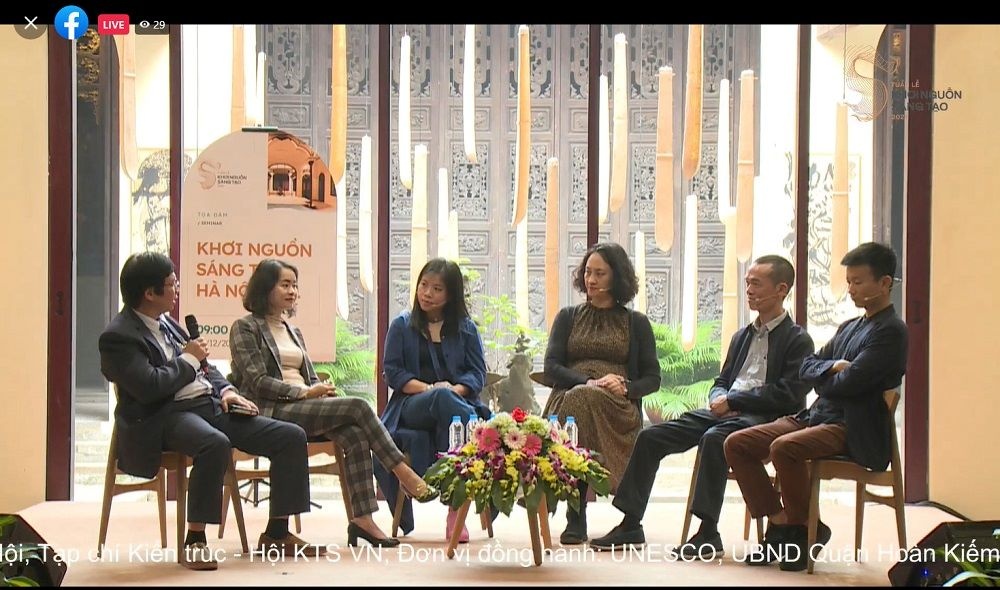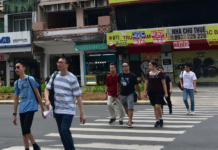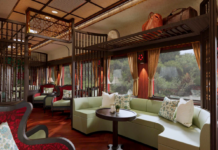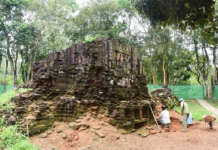Regulators and policy-makers attending at the seminar entitled “Unleashing Creativity – Hanoi 2021” discussed and assessed the potentials, opportunities and challenges in promoting the formation of creative communities, the search for design ideas and the exploitation of the capital’s creative spaces, thereby improve Hanoi’s competitive position against other regional cities.
The event was the first activity of a series “Unleashing Creativity Week 2021” program organized by the Hanoi Department of Culture and Sports.
| The participants of the seminar. Photo: Architecture Magazine |
Great potentials
Hanoi is known worldwide as the “Capital of Human Conscience and Dignity”, “City for Peace”, and “Creative City”, which has hosted important national and international events. Moreover, it is home to many typical cultural heritages including the Thang Long Imperial Citadel, a World Heritage Site, 20 special national relics as well as 1,441 city-level vestiges.
Participants at the workshop pointed out Hanoi also possesses natural heritage, in which rivers are most frequently mentioned. In the studies of architects and planners, the city is often referred to as a city inside the rivers (“Hanoi” literally means “inside the rivers”) with 20 major waterways.
The city has many beautiful landscapes, particularly Hoan Kiem Lake and Ngoc Son Temple, along with other buildings recognized by the Prime Minister as special national relics.
| King Le Thai To Temple in Le Thai To Street, Hang Trong Ward, Hoan Kiem District, Hanoi. Photo: Vinh Pham |
Hanoi also has 1,793 intangible cultural heritages, of which, the city has five heritages registered by UNESCO and 26 heritages enlisted as national-level intangible heritages by the Ministry of Culture, Sports and Tourism. The titles of People’s Artisan and Outstanding Artisan have been conferred upon 76 people in Hanoi by the State President in the field of intangible cultural heritage.
Additionally, Hanoi has a rich culinary background. At the 11th Vietnam-France Decentralized Cooperation Conference in Paris in 2019, Hanoi promoted Giang coffee, spring rolls, Hanoi’s pho (beef noodles) and bun cha (rice vermicelli with grilled pork) which are known by people in France as well as international visitors,” said Pham Thi Lan Anh, Head of Cultural Heritage Management, Hanoi Department of Culture and Sports.
Similarly, there are about 1,350 craft villages around the capital city. In particular, many of these villages’ trades are unique to Hanoi, such as to he (toy figurines) making in Xuan La Village, Phu Xuyen District, or bamboo dragonfly making. Other two craft villages which received special planning and investment from the city to promote and preserve their values are Bat Trang with pottery and Van Phuc with silk-weaving.
Striving to become the leading creative city
| The interior of the AgoHub creative space in Hanoi. Photo: AgoHub |
According to Lan Anh, of the 10 working programs of the municipal Party Committee for the 2020-2025 term, there are two programs that emphasize the implementation of contents committed when the city joined the creative cities network.
These are the program on cultural development, improving the quality of human resources, developing civilized and elegant Hanoi people in the 2021-25 period, and the one on promoting science-technology development and innovation in the city.
Hanoi has also issued plans to implement initiatives related to the creative cities network and the Resolution on the development of the capital’s cultural industry in the 2021-25 period, with a vision to 2045, while continuing to complete the amendments to the capital’s Law for submission to the National Assembly.
“We believe in the city’s potentials and development. There have been many questions to UNESCO as to the reasons for not addressing the issue of creativity in dynamic cities of Vietnam such as Danang or Ho Chi Minh City,” said Pham Thi Thanh Huong, Head of Cultural Department at UNESCO Office in Hanoi.
However, those questions only look at infrastructure rather than the rich cultural capital. If Hanoi takes the lead, it will inspire other cities while becoming a city truly worth living in and creating a truly sustainable vision, she said.







